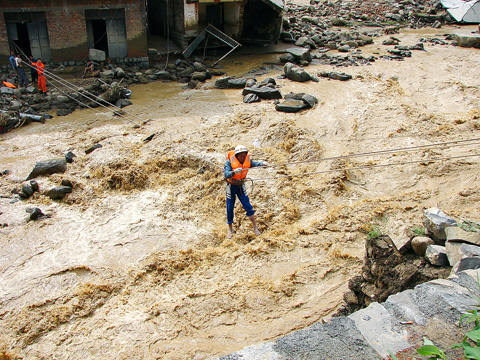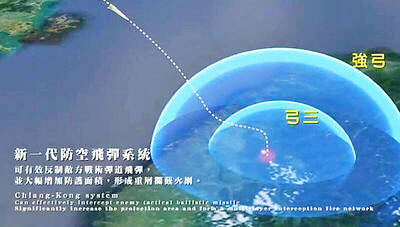Tens of thousands of victims of China’s earthquake were evacuated yesterday as torrential rain lashed the region, triggering flood warnings on major rivers including the Yangtze and the Pearl.
Heavy downpours have battered large parts of eastern and southern China, leaving at least 65 dead or missing, and adding to the misery in Sichuan Province.
Up to 70,000 people in Wenchuan County at the epicenter of the May 12 earthquake were being moved because of the risk of rock and mudslides brought on with the onset of the rainy season in Sichuan, the Beijing News said.

PHOTO: AFP
“Wenchuan has already entered the rainy season and the rain will weaken even more the already brittle mountain sides, making the situation even worse,” the paper said.
Xinhua news agency said about 50,000 people living in mountainous villages around Wenchuan County seat would be moved to camps already housing tens of thousands of other quake victims.
Last month’s magnitude-8 earthquake has left up to 87,000 dead or missing and up to 5 million homeless in Sichuan.
Wenchuan was flattened during the quake with early rescue and relief efforts mostly flown in because of impassable roads in the area.
Local weather reports said the Wenchuan area could expect thunderstorms for the next three days.
In China as a whole, heavy rains have left at least 57 people dead and eight missing across nine provinces over the past 10 days, the government said.
More than 1.27 million people have been evacuated in the hardest hit areas, with large swathes of farmland submerged and economic losses already totaling more than 10 billion yuan (US$1.4 billion), it said.
Rising waters on China’s major rivers prompted the government to issue emergency orders on Sunday as the affected provinces and regions scrambled to prepare for more torrential rains.
Waters on a Yangtze tributary in Henan Province were up to 4.7m over warning levels, E Jingping, head of the state’s flood prevention headquarters, said in an emergency order posted on its Web site yesterday.
The situation on the Pearl River in Guangdong and Guangxi provinces was the most pressing, he said, with water levels at a 20-year high.
On the Xijiang River, a tributary of the Pearl in Guangxi, water levels had surpassed warning levels by 6.8m, he said.
Almost 18 million people had been affected by flooding while more than 141,000 homes had been wrecked or damaged, the government said.
Rains were forecast to continue to pound southern China in the coming days, with rising river levels threatening towns in Jiangxi, Guangxi and Guangdong provinces, the state meteorological bureau said.

LIMITS: While China increases military pressure on Taiwan and expands its use of cognitive warfare, it is unwilling to target tech supply chains, the report said US and Taiwan military officials have warned that the Chinese People’s Liberation Army (PLA) could implement a blockade within “a matter of hours” and need only “minimal conversion time” prior to an attack on Taiwan, a report released on Tuesday by the US Senate’s China Economic and Security Review Commission said. “While there is no indication that China is planning an imminent attack, the United States and its allies and partners can no longer assume that a Taiwan contingency is a distant possibility for which they would have ample time to prepare,” it said. The commission made the comments in its annual

DETERMINATION: Beijing’s actions toward Tokyo have drawn international attention, but would likely bolster regional coordination and defense networks, the report said Japanese Prime Minister Sanae Takaichi’s administration is likely to prioritize security reforms and deterrence in the face of recent “hybrid” threats from China, the National Security Bureau (NSB) said. The bureau made the assessment in a written report to the Legislative Yuan ahead of an oral report and questions-and-answers session at the legislature’s Foreign Affairs and National Defense Committee tomorrow. The key points of Japan’s security reforms would be to reinforce security cooperation with the US, including enhancing defense deployment in the first island chain, pushing forward the integrated command and operations of the Japan Self-Defense Forces and US Forces Japan, as

INTERCEPTION: The 30km test ceiling shows that the CSIST is capable of producing missiles that could stop inbound missiles as they re-enter the atmosphere Recent missile tests by the Chungshan Institute of Science and Technology (CSIST) show that Taiwan’s missiles are capable of intercepting ballistic missiles as they re-enter the atmosphere and pose a significant deterrent to Chinese missile threats, former Hsiung Feng III missile development project chief engineer Chang Cheng (張誠) said yesterday. The military-affiliated institute has been conducting missile tests, believed to be related to Project Chiang Kung (強弓) at Pingtung County’s Jiupeng Military Base, with many tests deviating from past practices of setting restriction zones at “unlimited” and instead clearly stating a 30.48km range, Chang said. “Unlimited” restrictions zones for missile tests is

PUBLIC SAFETY: The nationwide distribution campaign aims to enhance society’s overall understanding of threats and bolster defense awareness, an official said The latest edition of the National Public Safety Guide is being mailed to all citizens starting today to foster public awareness of self-defense in the event of war or natural disasters, the Ministry of National Defense said yesterday. “The guides will be disseminated to the public to enhance society’s overall understanding of threats and bolster defense awareness, demonstrating the government’s emphasis on people’s safety and its determination to pursue self-defense,” All-out Defense Mobilization Agency Director Shen Wei-chih (沈威志) said at the ministry’s news conference. The nationwide distribution campaign was planned according to President Lai William’s (賴清德) Sept. 20 directive, he said, adding